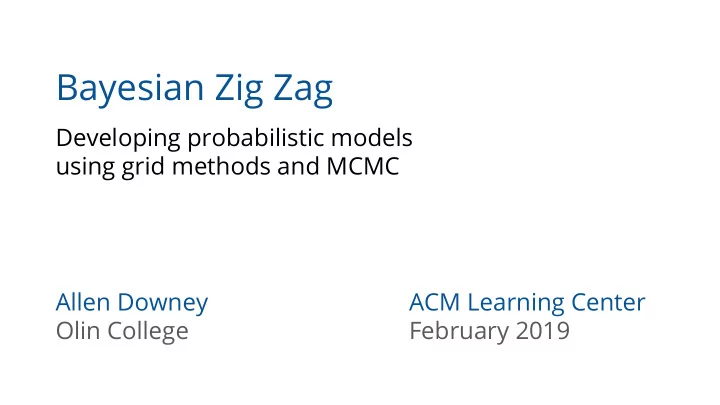

Bayesian Zig Zag Developing probabilistic models using grid methods and MCMC Allen Downey ACM Learning Center Olin College February 2019
These slides tinyurl.com/zigzagacm
Bayesian methods Increasingly important, but …
Bayesian methods Increasingly important, but … hard to get started.
Bayesian Zig Zag An approach I think is good for 1. Learning. 2. Developing models iteratively. 3. Validating models incrementally. Forward and inverse probability.
Forward probability You have a model of the system. You know the parameters. You can generate data.
Inverse probability You have a model of the system. You have data. You can estimate the parameters.
Start forward Simulate the model.
Go backward Run grid approximations.
Go forward Generate predictive distributions. And here is a key...
Go forward Generate predictive distributions. Generating predictions looks a lot like a PyMC model.
Go backward Run the PyMC model. Validate against the grid approximations.
Go forward Use PyMC to generate predictions.
Let's look at an example.
Hockey? Well, yes. But also any system well-modeled by a Poisson process.
Poisson process Events are equally likely to occur at any time. 1. How long until the next event? 2. How many events in a given interval?
Let's get to it These slides tinyurl.com/zigzagacm Read the notebook: ● Static view on GitHub. ● Live on Binder.
I'll use Python code to show: ● Most steps are a few lines of code, ● Based on standard libraries (NumPy, SciPy, PyMC). Don't panic.
STEP 1: FORWARD
Simulating hockey Probability of scoring a goal in any minute is p . Pretend we know p . Simulate 60 minutes and add up the goals.
def simulate_game(p, n=60): goals = np.random.choice([0, 1], n, p=[1-p, p]) return np.sum(goals)
Analytic distributions Result of the simulation is binomial. Well approximated by Poisson.
mu = n * p sample_poisson = np.random.poisson(mu, 1000)
To compare distributions, cumulative distribution function (CDF) is better than probability mass function (PMF).
Forward So far, forward probability. Given mu , we can compute p(goals | mu) . For inference we want p(mu | goals) .
Bayes's theorem tells us how they are related. By mattbuck (category) - Own work by mattbuck., CC BY-SA 3.0, https://commons.wikimedia.org/w/index.php?curid=14658489
STEP 2: INVERSE
Bayesian update Start with prior beliefs, p(mu) , for a range of mu . Compute the likelihood function, p(goals | mu) Use Bayes's theorem to get posterior beliefs, p(mu | goals) .
def bayes_update(suite, data, like_func): for hypo in suite: suite[hypo] *= like_func(data, hypo) normalize(suite) suite : dictionary with possible values of mu and probabilities data : observed number of goals like_func : likelihood function that computes p(goals | mu)
from scipy.stats import poisson def poisson_likelihood(goals, mu): """Computes p(goals | mu) """ return poisson.pmf(goals, mu)
Gamma prior Gamma distribution has a reasonable shape for this context. And we can estimate parameters from past games.
alpha = 9 beta = 3 hypo_mu = np.linspace(0, 15, num=101) gamma_prior = make_gamma_suite(hypo_mu, alpha, beta)
Grid approximation mu is actually continuous. We're approximating it with a grid of discrete values.
posterior = gamma_prior.copy() posterior.bayes_update(data=6, poisson_likelihood)
From posterior to predictive Posterior distribution represents what we know about mu . Posterior predictive distribution represents a prediction about the number of goals.
STEP 3: FORWARD
Sampling To sample the posterior predictive distribution: 1. Draw random mu from the posterior. 2. Draw random goals from Poisson(mu) . 3. Repeat.
def sample_suite(suite, n): mus, p = zip(*suite.items()) return np.random.choice(mus, n, replace=True, p=p) suite : dictionary with possible values of mu and probabilities
sample_post = sample_suite(posterior, n) sample_post_pred = np.random.poisson(sample_post)
Posterior predictive distribution Represents two sources of uncertainty: 1. We're unsure about mu . 2. Even if we knew mu , we would be unsure about goals .
Forward PyMC I'll use PyMC to run the forward model. Overkill, but it helps: ● Validate: does the model make sense? ● Verify: did we implement the model we intended?
model = pm.Model() with model: mu = pm.Gamma('mu', alpha, beta) goals = pm.Poisson('goals', mu) trace = pm.sample_prior_predictive(1000)
This confirms that we specified the model right. And it helps with the next step.
STEP 4: INVERSE
model = pm.Model() with model: mu = pm.Gamma('mu', alpha, beta) goals = pm.Poisson('goals', mu) trace = pm.sample_prior_predictive(1000)
model = pm.Model() with model: mu = pm.Gamma('mu', alpha, beta) goals = pm.Poisson('goals', mu, observed=3) trace = pm.sample(1000)
STEP 5: FORWARD
post_pred = pm.sample_posterior_predictive(trace, samples=1000)
With a working PyMC model, we can take on problems too big for grid algorithms.
Two teams Starting with the same prior: ● Update BOS with observed=3. ● Update ANA with observed=1.
model = pm.Model() with model: mu_BOS = pm.Gamma('mu_BOS', alpha, beta) mu_ANA = pm.Gamma('mu_ANA', alpha, beta) goals_BOS = pm.Poisson('goals_BOS', mu_BOS, observed=3) goals_ANA = pm.Poisson('goals_ANA', mu_ANA, observed=1) trace = pm.sample(1000)
Probability of superiority mu_BOS = trace['mu_BOS'] mu_ANA = trace['mu_ANA'] np.mean(mu_BOS > mu_ANA) 0.67175
post_pred = pm.sample_posterior_predictive(trace, samples=1000) goals_BOS = post_pred['goals_BOS'] goals_ANA = post_pred['goals_ANA']
Probability of winning win = np.mean(goals_BOS > goals_ANA) 0.488 lose = np.mean(goals_ANA > goals_BOS) 0.335 tie = np.mean(goals_BOS == goals_ANA) 0.177
Overtime! Time to first goal is exponential with 1/mu . Generate predictive samples.
tts_BOS = np.random.exponential(1/mu_BOS) tts_ANA = np.random.exponential(1/mu_ANA) win_ot = np.mean(tts_BOS < tts_ANA) 0.55025
total_win = win + tie * win_ot 0.58539425
Summary
Go Bruins!
Think Bayes Chapter 7: The Boston Bruins problem Available under a free license at thinkbayes.com. And published by O'Reilly Media.
Please don't use this to gamble First of all, it's only based on data from one previous game. Also...
Please don't use this to gamble Gambling a zero-sum game (or less). If you make money, you're just taking it from someone else. As opposed to creating value.
If you made it this far, you probably have some skills. Use them for better things than gambling.
https://opendatascience.com/data-science-for-good-part-1/
And finally...
Thanks Chris Fonnesbeck for help getting these examples running. Colin Carroll for adding sample_prior_predictive . Eric Ma for moderating today, and for contributions to PyMC.
These slides: tinyurl.com/zigzagacm website github downey@allendowney.com twitter email
Recommend
More recommend